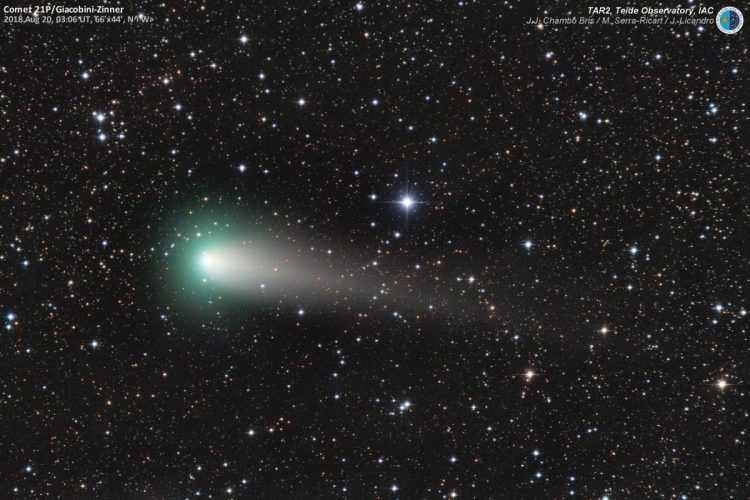From Thursday 7 to Sunday 10 October the annual Draconids meteor shower will be visible from the Comunidad Valenciana. Daniel Hazelhoff reports…
The Comunidad Valenciana will see the yearly autumn meteor shower from 7 until 10th of October. The Draconids shower is named after the Draco constellation, which is a large yet barely visible constellation due to the small amount of light it emits. The shower is also known as Giacobinids.
The showers appear to originate from the Draco constellation and are best viewed from the northern hemisphere, and in the evening as opposed to before dawn. Viewing the Draconids meteor shower is best done from a lying down position, and in areas of low light contamination so small towns and countrysides will have the best show. The Draconids shower is most likely to peak on 8 October.

The Draconids shower’s radiant point is from the head of Draco the Dragon constellation, near the stars Eltanin and Rastaban. Draco’s shower is peculiar, in the sense that it’s best viewed in the early evening as opposed to after midnight when the sky is darkest. This is because as the night passes Draconids’ radiant point sinks lower into the sky, reducing visibility until obstructed by the Earth itself.
This year Draconids pass us by while the moon is in its thin waxing crescent phase, giving off little light, which helps improve the shower’s visibility. Truly an optimal circumstance for this year’s meteor shower.
The Draconids aren’t usually a very visually intense shower, unless their parent comet, 21P/Giaboini-Zinner is present. On these rare occasions, the shower’s peak has rained down hundreds of meteors in an hour. The Draconids shower is debris from the 21P/Giaboini-Zinner comet, colliding with Earth’s upper atmosphere, burning up in the process.
Can you be more specific about the content of your article? After reading it, I still have some doubts. Hope you can help me.
Your ability to blend expertise with readability is impressive. I learned so much from this article. zeusbola
This article is proof that great writing can make any topic fascinating. Keep up the amazing work.
Your article is both inspiring and informative. I’ll definitely be coming back to read more of your work.
This is exactly the kind of insightful and well-structured content that makes a real impact. Brilliant job.
Your writing has a way of drawing the reader in and keeping them engaged until the very end. Amazing work.
Your article is truly outstanding! Every detail is carefully thought out, making it both engaging and informative. sv388 sabung ayam
This is one of the most well-researched and well-written pieces I’ve read on this topic. Great job. zeusbola
Your article is exceptionally well-crafted! The flow, depth, and clarity make it a joy to read.
Your research and attention to detail really shine through in this article. Amazing job.
Can you be more specific about the content of your article? After reading it, I still have some doubts. Hope you can help me. https://accounts.binance.com/el/register?ref=IQY5TET4
This is an outstanding piece of writing! Your ability to engage readers is remarkable.
This article doesn’t just present facts—it tells a compelling story that keeps the reader engaged. slot zeusbola
Your perspective on this topic is refreshing and insightful. It’s a pleasure to read. zeusbola
This is an outstanding piece of writing! Your attention to detail is truly remarkable. zeusbola
Your writing is both engaging and informative. It’s rare to find such a perfect balance. zeusbola
Your ability to keep the reader engaged from start to finish is truly impressive. zeusbola
Such a captivating read! You managed to explain everything in a way that really resonates.
There’s a quiet confidence in your tone that makes the message even more powerful — loved every word. zeusbola
You have a natural way of breaking things down clearly. zeustoto
This piece reflects not just skill, but heart — and that’s what makes it special. zeusbola
You’ve managed to stay focused while covering essential aspects. zeusbola
You’ve taken an insightful approach to this subject.
Explore the ranked best online casinos of 2025. Compare bonuses, game selections, and trustworthiness of top platforms for secure and rewarding gameplaycasino.
Thanks for sharing. I read many of your blog posts, cool, your blog is very good.
최저가격보장강남가라오케강남가라오케가격정보
최저가격보장강남가라오케강남가라오케가격정보
최저가격보장선릉셔츠룸선릉셔츠룸가격정보
최저가격보장강남가라오케강남가라오케가격정보
최저가격보장강남셔츠룸강남셔츠룸가격정보
최저가격보장CNN셔츠룸씨엔엔셔츠룸가격정보
최저가격보장강남룸싸롱강남룸싸롱가격정보
Your point of view caught my eye and was very interesting. Thanks. I have a question for you.
619138 437205I conceive this web internet site holds some real superb info for everybody : D. 701585
631970 248762Id ought to verify with you here. Which isnt 1 thing I often do! I get pleasure from reading a put up that will make individuals believe. Additionally, thanks for permitting me to comment! 876235
I don’t think the title of your article matches the content lol. Just kidding, mainly because I had some doubts after reading the article.
Can you be more specific about the content of your article? After reading it, I still have some doubts. Hope you can help me. https://accounts.binance.com/register?ref=P9L9FQKY
Thanks for sharing. I read many of your blog posts, cool, your blog is very good.
35096 469229You produced some decent points there. I looked online to the concern and discovered many people is going in addition to using your site. 991984
Can you be more specific about the content of your article? After reading it, I still have some doubts. Hope you can help me. https://www.binance.info/register?ref=P9L9FQKY
Can you be more specific about the content of your article? After reading it, I still have some doubts. Hope you can help me.
Thanks for sharing. I read many of your blog posts, cool, your blog is very good.
I don’t think the title of your article matches the content lol. Just kidding, mainly because I had some doubts after reading the article.